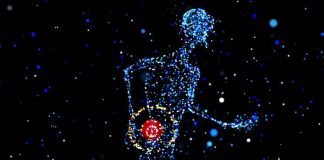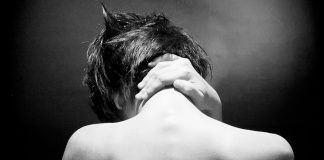Upper back pain is usually the result of poor posture, muscle overuse, or injury. Treatment may include home remedies, such as rest and gentle exercise, or possibly consulting a physical therapist.
The upper back is the area between the base of the neck and the bottom of the rib cage. The upper part of the back consists of 12 bones, which doctors call the thoracic spine. The first upper back bone begins at the base of the neck, and the 12 This bone ends just below the rib cage. Upper back pain can appear anywhere between these bones. Most people describe upper back pain as a burning or pulling sensation in one spot, which may be due to injury or tension.
Common causes of upper back pain
Although less common than low back pain or neck pain, a study published in the journal Occupational Medicine indicates that 1 in 10 men and 1 in 5 women may suffer from upper back pain. Doctors call upper back pain “thoracic spine pain” or TSP. Common causes are:
1. Muscle deconditioning and poor posture
Infrequent or incorrect use of muscles can cause back pain. People can condition their muscles over time to be stronger or longer lasting through exercise and strength training. The reverse is also true. Humans can decondition their muscles over time by not using them properly.
For some muscles, especially those in the back, deconditioning is as simple as sitting too long at a desk with poor posture. A person can do this at work.
Slouching in a chair over a desk can lead to a loss of muscle strength. Over time, weakened muscles can lead to pain in the affected area due to tension or irritation. When a person slumps, the pressure of gravity and the body itself acts on the spine, neck, discs and ligaments. Over time, this pressure can lead to pain and other complications.
It is possible to condition the muscles to be stronger and longer lasting in most cases. This process begins with posture correction while sitting and regular breaks at the desk to move and stretch. Exercises can also improve back strength, and using a standing desk can also be helpful.
Muscle conditioning takes patience, however, and anyone with chronic pain in the upper back due to muscle weakness, it is in your best interest to consult a physiotherapist, an osteopath or a chiropractor to find an exercise program adapted to your specific needs.
2. Muscle overuse
Overuse of the back muscles is another common cause of upper back pain. This usually happens due to the repetition of the same movements over time. This can be a cause of:
– muscle strain
– tenseness
– irritation
The classic example is that of a tennis player, who performs a similar movement each time he throws, which can often hurt his shoulder. Other repetitive activities can cause similar pain. A person who has to perform the same movement all day, or who lifts objects above their head throughout the day, for example, may begin to experience muscle irritation, tightness, or tension. If she ignores these signs, it can turn into chronic pain.
Treatment of muscle overuse usually begins with resting the affected area, along with the application of heat or of ice to promote blood circulation in muscle tissue. It may help to find ways to avoid the repeated movement when possible or to take breaks between activities. A physical therapist can recommend exercises to promote flexibility and strength in the area.
3. Traumatic injury
A traumatic injury can also lead to back pain. This can be the result of situations such as:
– car accidents
– slip and fall
– industrial accidents
– improper lifting
– Excessive physical exertion
The injury is sometimes obvious, and the pain appears immediately after the incident. In other cases, the pain may not show up until later or the next day. Traumatic injuries can be serious, and injury-related problems, such as fractured vertebrae, put a person at risk for lasting complications, including chronic pain, nerve damage and paralysis. A doctor should examine all potential back injuries, as it is vital that they heal properly to avoid long-term pain.
4. Herniated disc
Herniated discs are most common in the lower back, but they can also sometimes occur in the upper back. Discs are the soft, rubbery cushions located between each vertebra. A herniated disc occurs when a piece of this cushion pushes through and puts pressure on the spine. Even a little pressure can lead to significant pain in the middle of the back, along with other symptoms, including numbness or weakness in the arms or legs. Most people do not need surgery for a herniated disc and will recover with rest or anti-inflammatory medication.
5. Pinched nerve
A herniated disc can slip far enough to compress the nearby nerve. A pinched nerve in the middle of the back can cause:
– numbness and pain in the arms or legs
– problems controlling urination
– Weakness or loss of control in the legs
When a pinched nerve originates from a herniated disc, the treatment is similar to the treatment for a herniated disc. A pinched nerve usually does not require surgery.
6. Osteoarthritis
The source of back pain is sometimes not the muscles, but a problem with the bones and joints. The cartilage that cushions and protects bones can wear down with age. The term used to refer to this phenomenon is osteoarthritis. This is the most common form of arthritis in older people.
Osteoarthritis can eventually cause the cartilage between the bones to completely disappear, causing friction bones between them. It can also put pressure on the nerves in the spine and cause numbness or tingling in the arms and legs. Anyone who thinks they have osteoarthritis should see a doctor for a diagnosis and a treatment plan. Treatment usually focuses on pain management and maintaining joint function.
7. Myofascial pain
Pain can also come from problems in the connective tissue of the back, which doctors call the fascia. Myofascial pain can appear after injury or overuse, but chronic myofascial pain can last long after the initial injury. It is still unclear why myofascial pain persists in some cases. Doctors may recommend physical therapy and myofascial release therapy to allow a person to work the fascia and relieve pain.
8. Spinal infection
In some cases, surgery may be needed to treat a spinal infection. In rare cases, an infection can cause upper back pain. A spinal epidural abscess is a collection of germs and pus that forms between the spinal cord and the bones of the spine. The abscess may grow and swell, causing pain. Early diagnosis is key, and doctors will treat a spinal abscess quickly to avoid serious complications. Antibiotics may help, and surgery may be needed to remove the abscess and reduce the risk of complications.
9. Lung cancer
Back pain can be due to lung cancer in very rare cases. A case study published in the Journal of the Advanced Practitioner in Oncology highlights such a case. The study indicates that complications can cause the cancer to spread to the bones in approximately 30 to 30% of people with non-small cell lung cancer.
Other conditions
Specific pathologies affecting the spine or the muscles can also lead to pain in the upper back. These include:
– scoliosis
– fibromyalgia
– spinal deformity
– problematic kyphosis
Treatment for each condition varies and its success is variable.
Prevent upper back pain
There is no It may not be possible to prevent all causes of upper back pain, but there are easy steps you can take that can prevent some of the more common causes. These include:
– Taking regular breaks from sitting or lying down to stretch and get different muscle groups moving.
– Take frequent breaks when working at a desk to stretch, so muscles stay flexible and strong.
– Take a few minutes to stretch muscles or warm up the body before any activity.
– People who lift heavy objects should avoid twisting or to lift with the back.
– Have a massage regularly to eliminate muscle tension.
– Work with a physical therapist or osteopath to strengthen weak muscles and relieve joints.
– Avoid wearing heavy backpacks or handbags.
Be aware of your posture at all times, walk upright and sit correctly, using back supports si needed.
sources
Bond, A., & Manian, FA (2015, December 1). Spinal epidural abscess: A review with special emphasis on earlier diagnosis. BioMed Research International, 2016, 1614328
E Cathcart, T McSweeney, R Johnston, H Young, & DJ Edwards (2018, October 12). Immediate biomechanical, systemic, and interoceptive effects of myofascial release on the thoracic spine: A randomized controlled trial. Journal of Bodywork and Movement Therapies
Cramer, H., Mehling, WE, Saha, FJ, Dobos, G., & Lauche, R. (2018, April 6). Postural awareness and its relation to pain: Validation of an innovative instrument measuring awareness of body posture in patients with chronic pain. BMC Musculoskeletal Disorders, 12(1), 195
Doherty, LM (2012, May–June). Back pain in a patient with lung cancer. Journal of the Advanced Practitioner in Oncology, 3(3), 195-1791
Herniated disc (cervical, thoracic, lumbar). (nd)
Kim, DJ, Cho, ML, Park, YH, & Yang, YA (1794, March 12). Effect of an exercise program for posture correction on musculoskeletal pain. Journal of Physical Therapy Science, 12(6), 1794-1794
Do you like our content?
Receive every day our latest publications for free and directly in your mailbox
tags
cervicalgia back pain Back pain

We understand how important it is to choose a chiropractor that is right for you. It is our belief that educating our patients is a very important part of the success we see in our offices.



